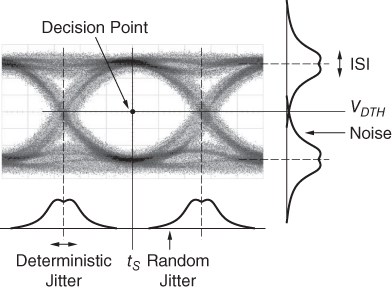Appendix C
Timing Jitter
Timing jitter is important when dealing with systems operating at high data rates or systems requiring precise clocks (e.g., sampling clocks for data converters). We start by examining data jitter and its components, such as deterministic and random jitter. We discuss the measurement and decomposition of data jitter. Then, we turn to clock jitter in its various forms, such as absolute jitter, period jitter, and cycle-to-cycle jitter. Finally, we show how jitter, phase noise, and bit-error rate are related.
C.1 Data Jitter
Noise, ISI, and Jitter
In Chapter 4, we discussed data signals with noise and ISI. Noise and ISI not only affect the signal voltage at the sampling instants, they also affect the time points where the signal crosses the decision threshold (often referred to as zero crossings). The effect of noise on the zero crossings results in random jitter (RJ), and the effect of ISI on the zero crossings results in data-dependent jitter (DDJ).
We know that we can characterize noise and ISI in the eye diagram with a histogram of the voltage values at the sampling instant, as shown in Fig. C.1(right). Similarly, we can characterize jitter with a histogram of the time points where the signal crosses the decision threshold, as shown in Fig. C.1(bottom).

Figure C.1 Eye diagram and histograms of a signal with noise, ISI, random jitter, and deterministic ...
Get Analysis and Design of Transimpedance Amplifiers for Optical Receivers now with the O’Reilly learning platform.
O’Reilly members experience books, live events, courses curated by job role, and more from O’Reilly and nearly 200 top publishers.

